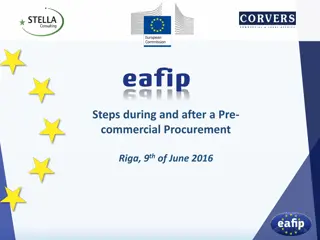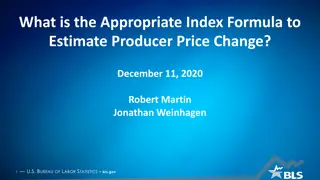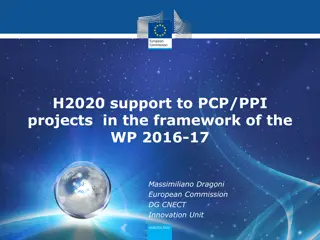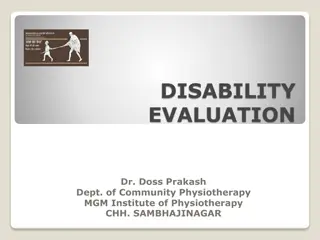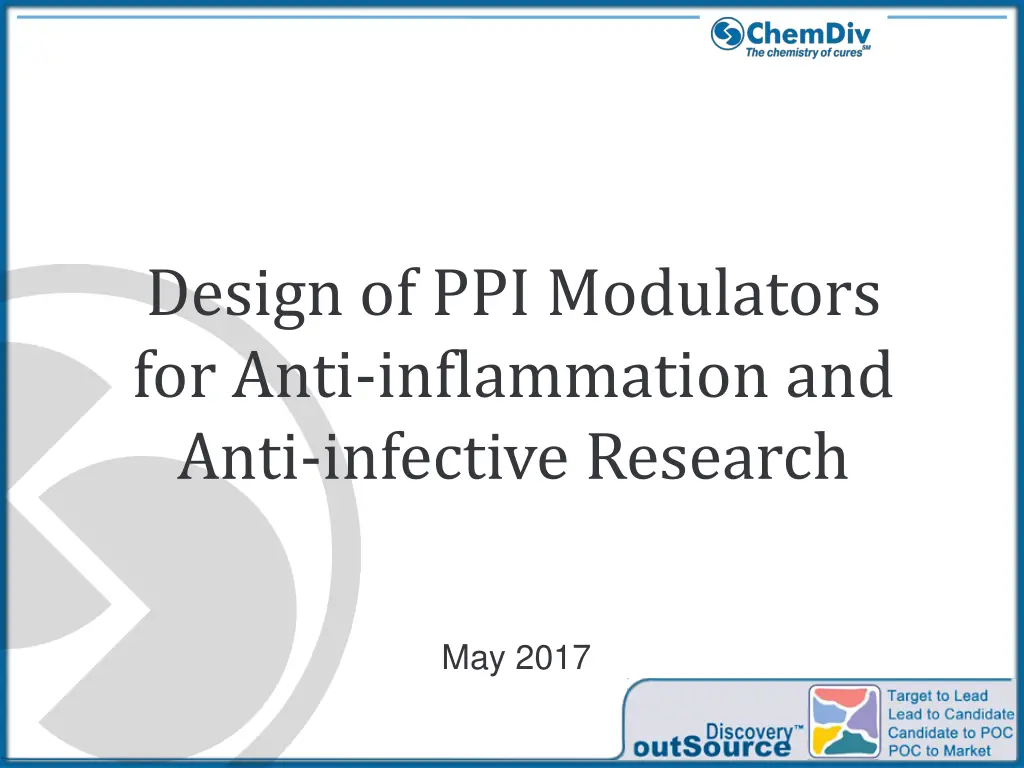
Exploring Protein-Protein Interactions for Therapeutic Modulation
Discover insights into the design, types, and classification of protein-protein interaction (PPI) modulators for anti-inflammation and anti-infective research. Learn about the properties of known PPI modulators and their potential in targeting a broad range of disease conditions.
Download Presentation

Please find below an Image/Link to download the presentation.
The content on the website is provided AS IS for your information and personal use only. It may not be sold, licensed, or shared on other websites without obtaining consent from the author. If you encounter any issues during the download, it is possible that the publisher has removed the file from their server.
You are allowed to download the files provided on this website for personal or commercial use, subject to the condition that they are used lawfully. All files are the property of their respective owners.
The content on the website is provided AS IS for your information and personal use only. It may not be sold, licensed, or shared on other websites without obtaining consent from the author.
E N D
Presentation Transcript
Design of PPI Modulators for Anti-inflammation and Anti-infective Research May 2017
Overview Protein-protein interactions (PPIs) represent a vast class of therapeutic targets both inside and outside the cell Protein protein interactions (PPIs) are involved in most cellular processes and influence biological functions - enzymatic activity, subcellular localization, and/or binding properties The human interactome has been estimated to cover ~400,000 protein protein interactions High-resolution structures showed PPI interfaces are generally flat and large (roughly 1000 2000 A2 per side) and considered difficult to target Mutational analysis of protein interfaces showed that not all residues at the PPI interface were critical but rather small hot spots conferred most of the binding energy (Arkin and Wells, 2004; Clackson and Wells, 1995). Hot spots tended to cluster at the center of the interface, to cover an area comparable to the size of a small molecule, to be hydrophobic, and to show conformational adaptivity Modulation of PPIs provide a wealth of opportunities for therapeutic intervention in a broad range of disease conditions
Types of PPI by Interaction Small interface and short peptide sequence for interaction Partner proteins with secondary structure binding to a hydrophobic groove Complex structure of interaction on both sides, multiple points of interaction PPI come in many shapes and sizes Most of the clinical-stage inhibitors target PPI primary interaction where the hot-spot residues are concentrated in small binding pockets (250 900 A2) and partner proteins are characterized by short primary sequences at the interface PPI that contain a single unit of secondary structure, such as an alpha helix, binding to a hydrophobic groove Globular interfaces, requiring tertiary structure on both sides of the PPI
Properties of the Known PPI Modulators (Examples) Primary Epitope Secondary Epitope PPI Target/Partner LFA1/ICAM1 cIAP/SMAC Compound Lifitergrast GDC-0152 GDC-0917/CUDC-427 AT-406/SM-406 Birinapant (+)-JQ-1 i-BET762 RVX-208 BI224436 MW 615 499 565 562 809 457 424 370 443 Oral BA PPI Target/Partner BCL family/BH3 Compound Navitoclax ABT-199 RG7112 RG7388 MI-888 PS210 MIV-6R MIV-2-2 OHM 1 MW 975 868 728 616 548 380 418 416 495 Oral BA - - + + - + + nd + + + + + + nd nd nd nd MDM2/p53 Bromodomain/histone PDK1/PIF-tide Menin/MML Integrase/LEDGF P300 CH1 domain/HIF1 Tertiary Epitope PPI Target/Partner IL-2/IL-2Ra HPV11 E1/E2 Compound SP4206 BILH434 MW 663 608 Oral BA nd nd Historically, PPI inhibitors have been larger and more hydrophobic than typical orally available drugs PPI oriented libraries with improved properties may enhance hit rate and ensure success in transition from ligandability into druggability
Examples of Anti-inflammatory PPI Modulators Structure surface) bound to SP4206 green sticks; PDB: 1PY2) of IL-2 (white SAR1118 (lifitegrast) inhibits binding of LFA1 (CD11a/CD18) to its ligand ICAM. The mechanism either involves binding directly to the ICAM site in the I domain of CD11a (Keating et al., 2006) or allosteric inhibition through binding to the I-like domain in CD18 (Shimaoka et al., 2003)
Examples of Anti-infective PPI Modulators Structure of transactivation domain of E2 protein from HPV11 (white surface) bound to BILH 434 (green sticks; PDB: 1R6N) Crystal structure of the dimerization interface of HIV integrase (white and cyan surface) bound to compound 16 (green sticks; PDB: 4NYF) with overlaid epitope from LEDGF (magenta; PDB: 2B4J). Compound 16 is a precursor to the clinical compound BI 224436
Commercial Libraries Targeted at PPIs* No. of Compounds -turn-, macrocycles, spiro compounds Otava Chemicals 1,330 Otava Chemicals 1,020 Otava Chemicals 520 Asinex 7,000 ComInnex custom Life Chemicals 850 Life Chemicals 23,200 Life Chemicals 4,300 NQuix NA Supplier Design Method helix-, 3D-, peptidomimetics, ChemDiv 125,000** decision trees similarity search -turn mimetics shape analysis helix mimetics, macrocycles machine learning 2D fingerprint similarity rule-of-four NA * - Huggins et al; Chem Biol. 2015 Jun 18; 22(6): 689 703 Overcoming Chemical, Biological, and Computational Challenges in the Development of Inhibitors Targeting Protein-Protein Interactions ** - Library size as published
Structure of ChemDiv PPI Library 5% 5% Peptidomimetics 10% Recognition Elements 44% Shape Spiro 18% 3D mimetics Macrocycles 18% Total Library size 210K compounds
Turn Mimetics and Approaches for Targeting
Scaffolds of Known -Turn Mimetics (Examples)
Principles of -Turn Mimetics Design* (Example) * - Witby, L.R. ; Boger, D.L. Comprehensive Peptidomimetic Libraries Targeting Protein-Protein Interactions. Acc. Chem. Res. 2012, 45, 1698 1709
ChemDivs-Turn Mimetics (Examples) R1 O R1 O O R1 H N O N O N N R N H R2 O O R3a N N H N N R3b O R H N H N O R3 R3 O N R2 O R2 H R1 O R1 O R N R1 O O N N N N O N H N N O R N R2 H N N O N NH H R3 H N NH R3 H N R3 R2 O N R2 O N O R
Helix Mimetics and Approaches for Targeting -Helices are common protein secondary structure elements Interacting residues occupy predominantly i, i+3 or i+4, and i+7 positions
Strategy for the Design of Helix Mimetics mimicry of helix by polycyclic small molecule scaffolds mimicry of side-chain residues on one face of the -helix three points of mimetics interaction with 7-ala helix at i, i+4 (or i+3) and i+7 positions possible H-bond, hydrophobic, electrostatic or - -interaction include hydrophilic and lipophilic regions in the scaffolds avoid polycyclic aromatics (as terphenils). High Fsp3 i i+4 i+7 Energy minimized poly- and 7-alanine -helix displaying i, i + 4, and i + 7 positions
Examples of Known Helix Mimetics N O H H N O H N O O O H H N O N C l O N H N O O O H N O N N H N N N N H C l H O N H O N O N H O O H + N H N O O Most physicochemical properties of the known alpha-helix mimetics have sub-optimal
New Scaffolds of -Helix Mimetics R1b R2a O R1a N O R2b N O O R1a N N R2c R2e N R1b R2d R2d H N R2d R2d R2c R2c R2e O N N R2b N R1b N R2b R2a R1a R2a R2d R4 R2e O R1b R2c O R1 O N R1 N R1a OH R2b N N O N R1a R2a N H R3 N N R2 N R1b OH O R2 N N N R2 N R3 O N R2 O R1 O R3 Over 200 scaffold templates have been developed
In-silico Design Validation H lipophilic O O -interaction N N N O H-bond MW 373.5 ClogP 2.23 ionic bond PSA 56.25 H-donor 1 H-acceptor 6 Rot bond 7 H-bonds Fsp3,% 66.7 ionic bond Dipole 3.76 Max distance, 15.38 Energy minimized three-dimensional interaction with 7-ala (~100,000 iterations) Indicated directions show the favorable H-bond formation (distance ~ 2-3 ) Intermolecular forces were taken into account
Macrocyclic as PPI Modulators R3 R3 R3 O ( )n ( )n N N N O R1b N ( )n R1a N N N R2 R2 R2 O O O R1a R3 O O R3 N R1b O N R2 R1b N N R3 N N N O N R1a ( )n ( )n O ( )n N N R1b N R1a R2 R2 R1 R1 R1 R3 O N O O O ( )n N N ( )n ( )n N R3 Ar N N N R2 N R2 R2 R3
Spiro Compounds as PPI Scaffolds (Examples) R2 R2 R2 R2 N N N N N R1 N N N NH O O O N R1 N N N R1 R1 R2 R1 R2 N N N O H H N N N R1 R1a N N N O R3 N R1b R2 N N R1a R2 N R2b
Peptidomimetics: PLG-Mimetics Design Example D e s i g n N R2b O N N R2a O O modulator of the dopamine D2 receptor N N O PLG O N N N O R4 O N O plg-01 N R1 N 1 R3 O N N E v o l u t i o n O N O O 2 N N N O N O N 3 O Core alignment: Green starting PLG violet plg-01 scaffold N N O N O N 4 O N
Library Statistics Parameter Value 210,000 2,599 960 2,539 0.8160 Total Library Size Number of Scaffolds Number of Unique Heterocycles Singletones Diversity, compounds Library size, number of scaffolds and number of unique heterocycles are updated constantly due to development of novel approaches to the design and in-house novel chemistries research ChemDiv s PPI Library is customizable for customer needs screening throughput, specific interaction Compounds can be cherry picked Library will be formatted to customer specification plates, racks, solutions, dry powder et cet Diversity is calculated by Tonimoto algorithm
ChemDivs PPI Library Physicochemical Properties Molecular Weight Distribution
ChemDivs PPI Library Physicochemical Properties Hydrogen Bond Acceptors Hydrogen Bond Donors Rotational Bonds N+O
ChemDivs PPI Library Physicochemical Properties logP logD PSA
ChemDivs PPI Library Largest commercially available PPI library Designed to cover most epitope, hot-spot interactions Unique chemistry strong IP potential Customizable to customer needs Size Cherry-picking Format options Delivery options Expandable from stock and synthesis Attractively priced










